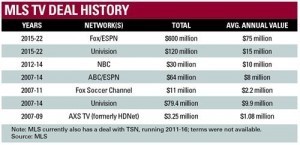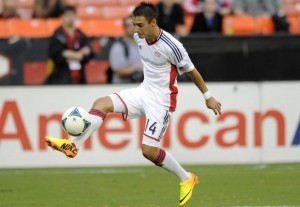Laurent Dubois's Blog, page 84
January 19, 2015
L’histoire et l’évolution du stade Vélodrome
Situé dans le 8e arrondissement de la ville de Marseille le long du Boulevard Michelet, le stade Vélodrome a connu de nombreux changements. Imaginé en 1930 puis inauguré en 1937, il est construit comme une enceinte sportive polyvalente pouvant accueillir des courses cyclistes (d’où son nom), des matchs de rugby et de football, ainsi que d’autres disciplines. Tout juste champions de France pour la première fois de son histoire, l’Olympique de Marseille joue son premier match (de gala) à guichets fermés contre l’un des plus grands clubs italiens de l’époque; l’équipe du Torino, et l’emporte 2-1.
Comptant initialement 35 000 places, il passe à 55 000 place en 1971 avant de revenir à 42 000 places après l’Euro 1984 à cause de la construction de loges et de boxes. A la fin des années 1990, il est agrandi pour accueillir 60 000 spectateurs lors de la Coupe du Monde de 1998. Comprenant aujourd’hui 67 394 places, il est le deuxième plus grand stade en France, et n’est devancé que par le Stade de France à Paris (à ne pas confondre avec le Parc des Princes, stade de l’équipe de football du PSG) en termes de capacité d’accueil.
Voici une rétrospective du stade de ses débuts à la maquette annoncée en 2011 comprenant un toît (sur la musique de l’entrée des joueurs) :
Vous pouvez aussi consulter ce site pour en lire plus au sujet de l’histoire du stade et de son évolution jusqu’en 1998.
Sa modification la plus récente qui a valu 267 millions d’euros d’investissement est donc l’ajout d’un toît en forme de vague qui lui donne une allure particulièrement esthétique, protège les spectateurs de la pluie et du vent et surtout, permet de conserver l’ambiance unique lors des matchs grâce à son acoustique qui empêche aux chants de s’envoler.
Cette modification de structure lui permettant d’entrer dans la catégorie 5 étoiles du classement de l’UEFA et d’être comparé à l’Allianz Arena du Bayern de Munich a cependant gommé la spécificité à ciel ouvert du stade Vélodrome, et est parfois regrettée par certains supporters. Cette nostalgie et les inconvénients du toît sont analysés par Jonathan Bartoli dans cet article.
Jugez vous-mêmes grâce à cette vidéo d’inauguration :
Retour au Stade Mosson après les Inondations
Suivi les catastrophes naturelles de septembre et octobre, le stade de Montpellier a subi six million d’euros en projet de reconstruction afin de relancer le club dans une bonne direction. Avec l’inondation et la destruction de La Mosson, plusieurs avancements se sont mis en marche en commencent évidement d’abord avec une nouvelle pelouse mais aussi de nouveaux bancs, vestiaires, et branchement électriques pour improuver la communication dans le stade. Avec l’aide du maire de Montpellier, toutes ces améliorations ont était finisses en façon record, juste en temps d’accueillir L’Olympique de Marseille vendredi passer; le 9 Janvier.
Dans ce match émotionnel attendu par de milliers de spectateurs, le leader de la Coupe Française à essayer de pas perdre un deuxième match de suite contre l’équipe de Montpellier, et leurs anticipation de jouer dans leurs nouveau stade Mosson. Malheureusement l’équipe Marseillaise n’a pas pu surmonter leur marasme et on finit avec un deuxième déficit de 2-1 contre l’opprimé. Kevin Berigaud a marquait en premier suivi par Paul Lasne, les deux pour Montpellier, et enfin Billel Omrani pour L’Olympique de Marseille ; leur donnant un deuxième défet pour la semaine et en récompensant Montpellier avec leur première victoire depuis quatre jeux. Avec les attaques terroristes de Paris, ce match était très émotionnel pour les deux équipes et n’à surtout pas manquer de suspense.
http://www.midilibre.fr/2014/12/23/mo...
January 18, 2015
The Beauty that lies in Unpredictability
Some of the most wonderful memories that I have of my own childhood were the countless weekends I spent watching soccer match after soccer match from the comfort of my own living room. The English Premier League was a constant in my world. My dad would sit next to my sister and I making the most profound and perceptive comments that we could only hope one day to truly understand! Eduardo Galeano perfectly emulates my own father’s perspective when he says “I’ve learned to accept myself for who I am: a beggar for good soccer… And when good soccer happens, I give thanks for the miracle and I don’t give a damn which team or country performs it”. This was my father’s motto, and what I loved about this motto was the unedited and unapologetic love for the beauty of the game.
My dad could sit and watch soccer for hours, and not only this, but he would spend hours listening to the radio both before and after the game – allowing the game to live on past the allotted 90 minutes. He was enthralled by the commentators. He would happily sit in the corner of our living room, and not even look at the television whilst a game was on. The most expressive and exceptional commentators had the ability to bring a match to life in his mind merely through their choice of words.
Commentating has become such a huge part of the game, so huge that it has become hard to imagine watching a game without it. There is beauty that lies in the way commentators interact with one another and bring the emotions of the game to life. And if there is one thing that soccer commentators thrive on, it is unpredictability.
Central to the powerful hold soccer has over me, it is the unpredictability of the game that fuels fans around the world. You cannot control the outcome of a soccer game, nor can you predict it. It is because of this that soccer transforms into one of the most wonderful playing fields, not only for the players and fans, but also for the commentators. It is a true skill to be able to depict every action and reaction within a game with a whole new flurry of words. However, so many sports today have become overrun by facts and figures. Statistics are the name of the game. If something happens in a game, a commentator is at the ready with numerical data to support its occurrence.
Trevor Noah, a South African comedian, makes some perceptive observations in reference to this and discusses the comparison between American football and basketball commentators in contrast to British soccer commentators. And although his commentary is exaggerated, I think it touches on the complex nature of the changing role of numbers within sports.
(You can skip ahead to 2:00 for the direct reference to soccer commentating – although the whole clip is relevant)
I think that what Noah captures so humorously in this clip is the overwhelming and at times unnecessary use of facts and figures used today to validate and compare athletic performances. At the end of the day, facts and figures can only take you so far. If soccer was a perfect game, one that could be predicted by which team had the highest numbers, the best players and the least number of errors, would it still be the beautiful game that we know and love? I don’t think it would be.
There is an ease and playful nature that comes along with any soccer game which, when reflected in the commentating, makes it a much more enjoyable experience. What we may be able to predict from past performances is washed away by human fallibility. As we have discussed in class numerous times, the unpredictability of soccer becomes a reflection of life itself. The roles that people play, the flawed justice system, the role of fate. The outcome of a soccer match is a surprise to everyone involved; fate does not play favorites. And this, exactly this, is why it is the unpredictability of soccer that makes it beautiful.
I leave you with the words of Uros Zupan, “beauty in soccer has no desire to destroy us; it can only bring light to our lives. What will destroy us are formulas and tactics. But before us, they will destroy the game itself.”
References:
Galeano, E. (2013). Soccer in Sun and Shadow. 14.
Turnbull, J. Satterlee & T. Raab, A. 2008. The Global Game: Writers on Soccer. 181.
Fußball und Nationalidentität in Deutschland
Die Deutschen lieben die Nationalmannschaft. Männer, Frauen, Kinder und Alten – alle sehen die Mannschaft. Im letzten Sommer war die Atmosphäre in Deutschland wunderbar, weil die Fußballweltmeisterschaft gespielt wurde. Deutsche Fahnen hingen über den Straßen und viele Leute trugen die Landesfarben–Schwarz, Rot, Gold. Jedes mal schoss die Mannschaft ein Tor, gab es viele Feuerwerkskörper. Während der WM hatten die Deutschen den Nationalstolz.
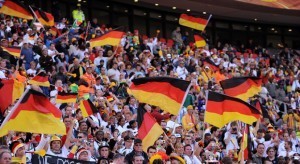
Impulse.de – Fußball, Fahnen, Fischstäbchen: Worauf Unternehmen bei WM-Aktionen achten sollten
In Deutschland ist Nationalstolz ein bisschen schwierig. Wie in anderen Länder ist die WM in Deutschland eine Ablenkung von Tagespolitik. Aber in Deutschland wirft die WM auch Fragen über Patriotismus auf. Aufgrund der Vergangenheit sind die Deutschen widerwillig, um Nationalstolz zu zeigen. Mit Ausnahme während der WM niemals tragen die Deutschen die Landesfarben oder weht die Nationalfahne.
Warum sind die Deutschen stolz auf Deutschland während der WM? Die WM vereinigt viele Menschen, weil sie Fußball mögen. Die WM ist eine Zeit, wenn Leute ihre Nation feiern können. Obwohl die Deutschen unterschiedliche Meinungen über Tagespolitik haben, sind sie stolz auf die Mannschaft.
Why was one of Africa’s greatest athletes forced to strip naked?
That is the question posed in an excellent essay by Shireen Ahmen, whose blog Tales of a Hijabi Footballer is a must-read for those interested in the global politics of global football. It is published at Football is a Country, part of the Africa is a Country blog.
The piece focuses on a recent incident of “gender testing” directed at Genoveva Anonma, a football player from Equatorial Guinea who was named Africa’s Female Footballer of the Year in 2012. It offers a powerful critique of the treatment of women’s football players by the sporting federations and institutions:
“Officials and administrators in football are supposed to be advocates for the beautiful game and for footballers — irrespective of gender. But the treatment of female players with regard to gender testing is deplorable. Officials have no boundaries when it comes to shaming female players.”
January 17, 2015
MLS and U.S. Television
Evidenced by last week’s assigned reading by Andrei Markovitz (The Other “American Exceptionalism” – Why Is There No Soccer in the United States?), individuals have long been debating the reasons for the U.S.’s lack of interest in soccer. One of the statements made in Markovitz’ 1988 article struck me, as he wrote that “soccer’s marginal existence as a major spectator sport in contemporary America has probably a lot more to do with its inability to land a long-term television contract with one of the major networks, than with it being ‘crowded out’ by baseball ‘from below’ and football ‘from above'” (Markovitz, 1988:145). Given that this article was written at a time when Major League Soccer (MLS) didn’t exist and that now U.S. television networks broadcast soccer from both the MLS and European leagues, there are two different lenses through which to analyze the influence of U.S. television contracts on the popularity of soccer in the U.S. The first of which examines the influence of the MLS and U.S. television contracts, and the second examines the influence of European leagues and U.S. television contracts. This blog post will focus on the history of MLS U.S. television contracts and their influence on American interest in soccer.
To provide a brief summary of MLS on U.S. television, the first major contract was signed in 1994 with ESPN. The contract was signed roughly two years before the first MLS match was played in April 1996, and it was set to last for three years, broadcasting 10 games on ESPN, 25 games on ESPN2, and the championship game on ABC. This deal split advertising revenue evenly between the league and the network, with no rights fees provided for the MLS.
Since this initial contract, ESPN has continued to broadcast MLS games up until present day. However, the MLS has signed other contracts here and there with other networks, all in a rather confusing jumble, with contracts lasting different amounts of time. One infographic highlighted the random assortment of TV contracts that the MLS has jumped into over the past 8 years:
(Image from here.)
Two major TV-soccer deals in recent history both involve ESPN: the first was an 8-year deal signed in 2006 between ESPN and MLS, worth $7-8 million annually in rights fees (the first TV contract to include rights fees for the MLS), and the second was another 8-year deal recently signed in May 2014 between ESPN, Fox Sports, and Univision Deportes, worth $90 million annually. With this most recent contract, in effect in 2015, MLS will receive five times the amount of money from rights fees than it was receiving in its previous TV contracts. Furthermore, for the first time, MLS will receive more money from their U.S. television contract than the English Premier League receives from its respective U.S. television contract with NBC (worth $85 million annually).
Do these expensive TV contracts with major sports networks indicate that the MLS, and soccer, are rising in popularity in the U.S.? For a deeper look at this, simply examine the TV ratings for the MLS Cup (the MLS championship match and arguably the most important match of the season). In 2013, the ESPN live broadcast of the MLS Cup had an average viewing audience of 505,000 people. This was the smallest audience ever for the MLS Cup on English-language television, 44% smaller than the 2012 MLS Cup and small even when compared to the 1.4 million viewers for the first MLS Cup in 1996. The referenced article makes the sad comparison that an old, syndicated episode of Everybody Loves Raymond also draws in a viewing audience of 505,000 people.
Based on TV ratings, it would appear that expensive TV contracts are not really drawing American interest to soccer. However, it is worth noting that with the new contract in effect in 2015, for the first time, MLS games will be on U.S. television on regularly scheduled days and times. Furthermore, strong brands like Chipotle and Heineken are signing sponsorship deals with the league, possibly indicating greater American interest in MLS and offering a hopeful future for the league. So when the 2015 MLS season begins on March 6, perhaps a new TV contract and new sponsorships will be just what the MLS needs to finally draw serious interest from the American population.
(Feature image from here.)
Revolution’s Diego Fagundez Cap-Tied to Uruguay, Ineligible to Play for USMNT
This past Thursday, New England Revolution youngster Diego Fagundez started for Uruguay in the South American Under 20 Championship, which, under current FIFA rules, will permanently exclude him from suiting up for the United States Men’s National Team in the future [1]. Many fans of the USMNT were hoping that the 19 year old would choose the US, a country he has lived in for most of his life, over Uruguay, the country in which he was born in. Fagundez has lit up Major League Soccer recently, scoring 22 goals and providing 18 assists in his 88 appearances, making him the most successful MLS Homegrown Player in the young history of the league [2]. However, while Fagundez has applied for US citizenship, he has not yet obtained it, meaning that he will be ineligible to use the one-time nationality switch that FIFA allows, as he was not a US citizen at the time he played for the Uruguay U20s in a competitive match [1]. Naturally, this has sparked discussion on the complexities of the United States’s immigration process, especially in the comment section of the article on the MLS website, MLSSoccer.com. In my opinion, someone who has been living in the country for 14 years should have a quicker path to citizenship, but unfortunately for Diego and fans of the USMNT, this is not currently the case. It will be interesting to follow him over the length of the tournament and see if he will make an appearance in the senior 2015 CONMEBOL Championships or the 2016 Copa America.
[1] http://www.si.com/planet-futbol/2015/...
[2] http://www.mlssoccer.com/news/article...
Photo courtesy of Nick Wass/AP
January 16, 2015
Fußballpolitik – im wahrsten Sinne des Wortes
Was haben sich Lahm, Schweini, Neuer & Co. gefreut, als nach dem mehr als geglückten WM-Auftakt gegen Portugal die Bundeskanzlerin höchstpersönlich in der Mannschaftskabine aufgetaucht ist, um zum verdienten Sieg zu gratulieren und den teilweise leichtbekleideten Weltmeistern in spe viel Glück für den weiteren Verlauf des Turniers zu wünschen. Ein Selfie hier, ein Selfie da und ab damit auf Instagram. Seien wir doch mal ehrlich, ob Merkel- bzw. CDU/CSU-Sympathisant oder nicht, irgendwie kann man dann schließlich doch nicht umher, das Grinsen abzustellen, sobald man Angie, umgeben von einer 23-köpfigen Horde halbwegs junger (schließlich war der angehende Rentner Miro Klose ebenfalls mit von der Partie), muskulöser Männer sieht, deren Namen jedem deutschen Bürger geläufiger sein dürften als die der Mitglieder des Bundeskabinetts. Und während ganz Deutschland sehnlichst auf das zweite Foto, diesmal mit dem goldenen Pokal, seit vergangenem Sommer auch besser bekannt als „das dicke dicke Ding“, hin fiebert, passiert 10.013 Kilometer nordwestlich der Copacabana im Berliner Bundestag etwas Eigenartiges, das jedoch regelmäßig im Zwei-Jahres-Turnus zu beobachten ist: Eben jenen Unbekannten, den Herren und Frauen Bundesminister/innen, ist auf einmal wahnsinnig viel daran gelegen, einen Gesetzesentwurf nach dem anderen zu verabschieden, und das mit einer Geschwindigkeit, die selbst Ex-Nationalspieler David Odonkor Konkurrenz gemacht hätte.
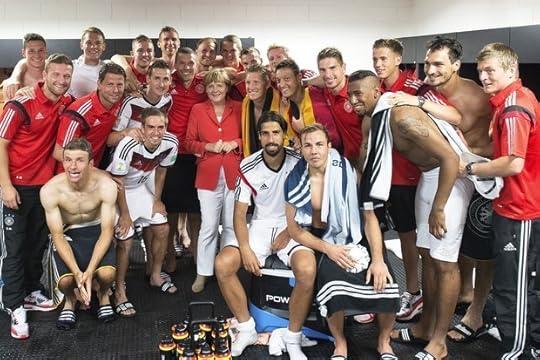
Ein Zufall, dass Finanzminister Wolfgang Schäuble die umstrittene Reform der Lebensversicherung bereits am 11. Juli – und damit zwei Tage vor dem WM-Finale – in Kraft treten sehen möchte oder dass Ursula von der Leyen darauf pocht, die Ausstattung der Bundeswehr mit bewaffneten Drohnen weiter voranzutreiben, möglichst bevor das Fußballfieber wieder abklingt? Wohl kaum.
Neu ist dieser Ansatz in der Politik nicht. So hat Angela Merkel am 16. Juni 2006 (Deutschland – ein Sommermärchen, wir erinnern uns?) beispielsweise eine Mehrwertsteuer-Erhöhung von 3% durchboxen können. 2010 folgte dann die Erhöhung der Krankenkassenbeiträge von 14,9% auf 15,5% und zwar an einem Freitag, zwei Tage nach Deutschlands 1:0-Erfolg gegen Polen. Der absolute Höhepunkt dann zum Halbfinale der Europameisterschaft 2012, als das „Gesetz zur Fortentwicklung des Meldewesens“ binnen 57 Sekunden verabschiedet wurde, schließlich durfte sich keiner der Abgeordneten die Partie Deutschland-Italien entgehen lassen. Besagtes Gesetz befähigt Einwohnermeldeämter, Privatadressen von Bürgern weiter zu verkaufen, zum Beispiel an Adressenhändler oder Werbetreibende.
Zurück ins Jahr 2014. Werfen wir doch einmal einen Blick auf die Tagesordnung der viertägigen Parlamentssitzung, die vom 24. Juni bis einschließlich 27. Juni stattfand. Zur Auswahl stehen unter anderem:
Antrag der Republik Litauen zum Euro-Beitritt
Gesetz zur Reform der Besonderen Ausgleichsregelung für stromkosten- und handelsintensive Unternehmen
Aussprache über die Beschaffung von Drohnen für Bundeswehr
Beschlussempfehlung des Haushaltsausschusses zum Finanzplan des Bundes bis 2017
Verlängerung des Bundeswehr-Einsatzes in Mali und im Libanon
Lebensversicherungsreformgesetz
Insbesondere letzterer Entwurf hat es in sich. Die Gesetzesänderung sieht u.a. eine Senkung des Garantiezinses für Neuverträge vor und begründet das Vorhaben mit einer andauernden, für die Versicherungen schädlichen Niedrigzinsphase. Klar, dass hier die Versicherten wohl oder übel den Kürzeren ziehen werden. Auffällig ist in diesem Zusammenhang vor allem die äußerst knapp bemessene Beratungsfrist, die für die Beschlussfassung angesetzt wurde. Üblicherweise seien vier bis sechs Wochen für ein solches Vorhaben vorgesehen. In einem Antrag fordert die Fraktion DIE LINKE, den Gesetzesentwurf einer eingehenderen Prüfung zu unterziehen. Dort heißt es:
“Die Zeit für die parlamentarische Beratung und Umsetzung des von der Bundesregierung vorgelegten Lebensversicherungsreformgesetzes (LVRG, „Entwurf eines Gesetzes zur Absicherung stabiler und fairer Leistungen für Lebensversicherte“, einschließlich zwei Verordnungen) ist viel zu kurz angesetzt. Das Zeitfenster von der Einbringung des Gesetzes bis zur Beschlussfassung reicht nicht aus: Nach einer öffentlichen Anhörung am 30. Juni 2014 wird der Entwurf bereits zwei Tage später durch den Finanzausschuss gewunken und soll am 4. Juli 2014 im Bundestag verabschiedet werden. Zudem sollen nach der Verabschiedung des Gesetzes im Bundesrat am 11. Juli 2014 bereits am Tag nach der Verkündung wesentliche Teile in Kraft treten.
Mit dem Gesetzentwurf beansprucht die Bundesregierung, die Risikotragfähigkeit der Lebensversicherer und die Stellung der Versicherungsnehmerinnen und -nehmer gleichermaßen zu stärken. Insgesamt ist die Regelungsmaterie sehr komplex. Ob der Gesetzentwurf dem Ausgleich der teilweise widerstreitenden Interessen zwischen Versicherungsunternehmen und Versicherungsnehmerinnen und -nehmern, einschließlich jener, deren Lebensversicherungspolicen in Kürze fällig werden, tatsächlich gerecht wird, bedarf der sorgfältigen Abwägung.
[…]
Ein anderes Bild zeigt eine detaillierte Untersuchung von über 60 Lebensversicherern, die ÖKO-TEST durchgeführt hat. Demnach verzeichnet die Branche der Lebensversicherungsunternehmen insgesamt trotz Niedrigzinsphase solide, teilweise sogar gestiegene Erträge und ist weit von einer Krisensituation entfernt („Auf Kos- ten der Kunden“, ÖKO-TEST 2/2014)
[…]
Bei einem Inkrafttreten von Teilen des Gesetzes bereits im Juli 2014 bleibt für Versicherungsnehmerinnen und -nehmer mehrheitlich keine Zeit zu prüfen, ob sie ihre Police nach der geltenden Rechtslage vorzeitig kündigen sollen oder ob es günstiger ist, den Vertrag laufen zu lassen.”
So schnell scheint sich die Opposition dann glücklicherweise doch nicht immer auf dieses Spielchen einzulassen.
Mal gucken, was der Bundestag 2016 so für uns bereithält. Eigentlich wäre doch mal wieder eine Steuererhöhung fällig, oder? Aber bis dahin freue ich mich erst einmal noch eineinhalb Jahre über den vierten goldenen Stern.
Quelle: Beitragsbild
Bedeutung des Fussballs in Deutschland
Fussball ist Nationalsport in Deutschland. Nicht nur durch die Weltmeisterschaft im eigenen Land in 2006 ist ein geschichtlich bedingtes, aber trotzdem vermisstes Nationalgefühl wieder mehr und mehr aufgekommen. Der Gewinn der Weltmeisterschaft im letzten Jahr hat den deutschen Fussball-Enthusiasmus nun endgültig auf die Spitze getrieben.
Ähnlich wie in den zu lesenden Artikeln beschrieben, eint Fussball auch in Deutschland verschiedene Gesellschaftsschichten, Generationen und Nationalitäten. Anders als in sehr armen Ländern fungiert der Sport allerdings nicht als Ablenkung von Krieg und Gewalt, sondern mehr als Nebenaktivität zu Job und deutscher Alltagspolitik. Trotzdem werden die deutschen Superstars wie Mario Götze und Manuel Neuer idolisiert, nicht nur national, sondern auch international. Rivalitäten zwischen deutschen Städten werden durch Fussball verkörpert und intensiviert, wie zum Beispiel das Duell Gelsenkirchen (Schalke 04) gegen Dortmund (BVB). Hierdurch zeigt sich, wie sehr sich Städte mit ihren jeweiligen Mannschaften identifizieren. Diese Leidenschaft kann mitunter zu Auseinandersetzungen von Fans führen und heizt die Debatte über Pyrotechnik in deutschen Stadien weiter an.
January 15, 2015
Transfer Window: Round 2
It is halfway through the 2014-2015 season, which means that the winter transfer window is now going on. Established during the 2002-2003 season of the English Premier League, the present transfer window system was introduced as a way to best preserve contractual stability for both the player and the club while allowing movement to occur at predetermined times. This allowed for contracts to be enforced and for the integrity of competitions to be maintained.
Transfer windows are both welcomed and feared by fans. For a fan whose team has not been living up to expectations, the transfer window is seen as an opportunity to buy a player who can be a real game changer. On the other hand, fans can definitely feel anxious about a team offloading strong players who just do not fit the manager’s future plans (believe me, I’m a Real Madrid fan so I know). The great thing about having two solidly set transfer windows is that fans will know that the squad will be settled for at least two parts of the season.
While the summer transfer window is when most of the excitement takes place, the January transfer window is also important and can deliver on some headline stealing deals. Since it occurs halfway through the season, it has the potential to make or break a team, fuel or terminate a season, and create or dismantle a player’s reputation. A January signing also differs from a summer signing in that the manager will need immediate impact from a January signing while a summer signing can be a way to invest in the future team.
The January transfer window has gathered mixed reactions from managers and players. It is complicated by different leagues’ time constraints, possible European and domestic cup ineligibility, and clubs resolutely holding on to their best players. This leads to inflated prices by the selling party, which means a preference for clubs who have strong finances to participate in this transfer window. Take for example the 2011 winter transfer window. Fernando Torres, unhappy with Liverpool’s situation, handed in his official transfer request and was sold to Chelsea for £50 million, making him the sixth most expensive footballer in history. With this money, Liverpool was able to then spend £35.5 million on Andy Carroll and £22.5 million on Luis Suarez. It should come of no surprise that Chelsea and Liverpool are two of the top January transfer window spenders.
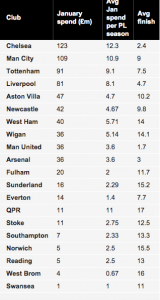
January transfer spend by current PL club (since 2003)
While the 2011 winter transfer season is definitely an exception, setting the record for the most spending for a winter transfer window at £225 million, it is clear that the January transfer window is not as low-key as some may think. Going back to the aforementioned example, the purchase of Luis Suarez became a pivotal moment for Liverpool. He went on to become a crucial player for the club and led the team to a 2nd place finish in the EPL. His transfer to FC Barcelona this season is strongly felt by Liverpool, as they are currently struggling to compete with the likes of Manchester United, Chelsea, etc. in the EPL (although I am sure Liverpool fans don’t miss the controversy and biting that surrounds him). On the other hand, Fernando Torres did not live up to the £50 million price tag, and received criticism for his low goal-scoring record.
As the competition heats up for all the leagues and cups, the January transfer window will prove important in shaping the rest of the season for many clubs. Those in relegation also will be looking to purchase players who can shake up the team. As an avid watcher of the English Premier League, I am looking forward to seeing some new players on my screen who can potentially become the next superstar.
Sources:
http://www.bbc.co.uk/sport/0/football/20793698
http://www.premierleague.com/en-gb/news/features/origins-of-transfer-window.html
Laurent Dubois's Blog
- Laurent Dubois's profile
- 44 followers





